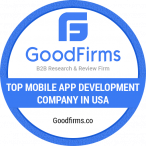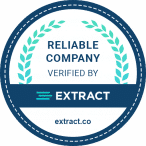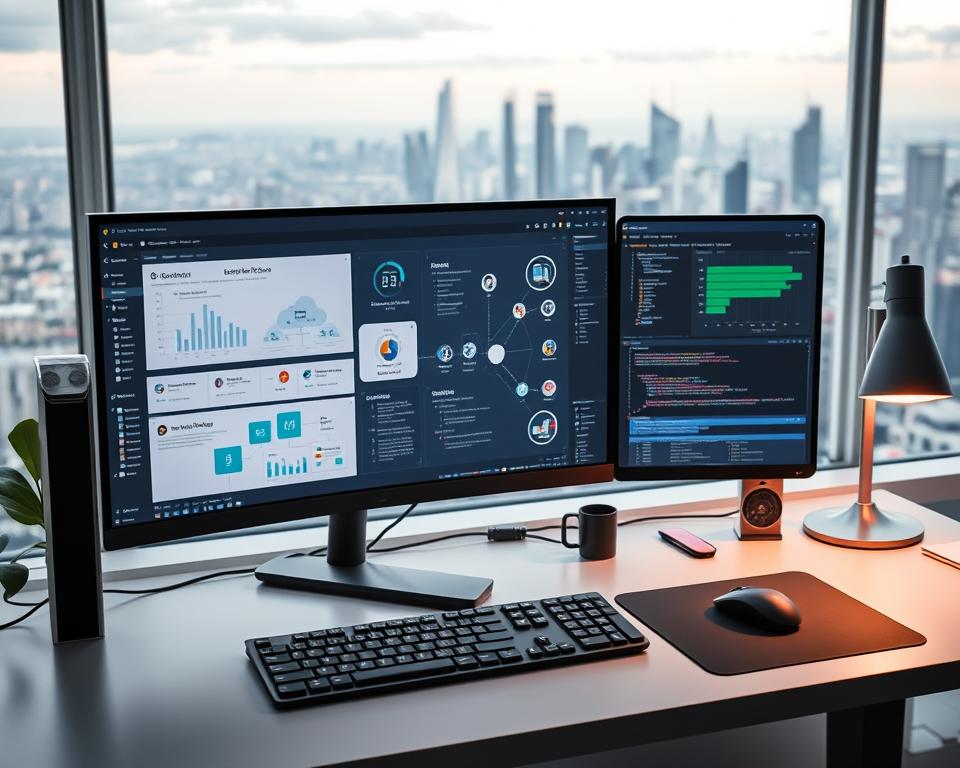Businesses are moving to cloud-based solutions more and more. SaaS application development is key in this shift. Multi-tenancy lets many users share the same resources. Cloud security is a big deal in SaaS development, and knowing about multi-tenancy is vital for secure apps. For more on SaaS app development, check out SaaS application development resources.
Creating a multi-tenant SaaS app needs careful thought on architecture and security. This ensures the app is safe, grows well, and follows rules. By sticking to SaaS and cloud security best practices, companies can make apps that users trust.
Table of Contents
Introduction to Multi-Tenant SaaS Applications
Multi-tenancy means many users can use the same resources. It’s great for saving money and boosting efficiency. But, it also brings special security issues that need strong cloud security steps.
Key Takeaways
- Multi-tenancy is a key feature of SaaS application development that enables multiple users to share the same resources.
- Cloud security is a top priority when it comes to SaaS application development.
- Understanding the benefits of multi-tenancy is essential for building secure and scalable applications.
- Developing a multi-tenant SaaS application requires careful consideration of architecture and security best practices.
- Following best practices in SaaS application development and cloud security is crucial for building trusted and reliable applications.
- Multi-tenancy presents unique security challenges that must be addressed through robust cloud security measures.
Understanding Multi-Tenant SaaS Architecture
Multi-tenancy is key in SaaS architecture. It lets many tenants use the same SaaS app, cutting costs and growing easily. This is great for cloud computing, where resources can adjust to meet needs.
In a multi-tenant setup, all tenants use the same infrastructure. Yet, each tenant has its own space. This ensures data isolation and keeps things secure.
Multi-tenancy brings many benefits. It lowers costs, grows easily, and makes upkeep simpler. SaaS providers can manage one app for all, making updates quick and easy.
What is Multi-Tenancy?
Multi-tenancy means a SaaS app can serve many tenants. Each tenant gets its own space, but they share the same setup. It needs careful planning to keep data safe and separate.
Benefits of Multi-Tenant Architecture
The perks of multi-tenant architecture are clear:
- Lower costs: No need for many app instances, saving money and using resources better.
- More scalability: Easy to grow or shrink to fit tenant needs.
- Better upkeep: Manage one app for all, making updates simpler.
Common Multi-Tenant Models
There are a few main multi-tenant models. These include shared everything, shared nothing, and hybrids. Each has its own pros and cons, depending on what the SaaS provider and tenants need.
Core Components of Multi-Tenant Applications
When developing SaaS applications, a solid multi-tenant architecture is key. It ensures the app is scalable and secure. The main parts are the application layer, database layer, and infrastructure layer. Together, they make a SaaS app that grows and stays safe.
The application layer deals with user requests and offers the app’s features. It’s built for many tenants to use the same app instance. This setup makes the app scalable and cuts costs. The database layer keeps and manages data for each tenant. It’s made to keep data safe and separate.
Important things to think about for multi-tenant apps include:
- Load balancing for high performance and uptime
- Caching to lessen database load and speed up responses
- Content delivery networks (CDNs) to spread content and lower latency
Scalability is vital in multi-tenant apps. It lets the app handle more users and traffic. By planning for growth, developers keep the app fast and secure, even with more users.
Database Architecture Strategies
Choosing the right database architecture is key for a multi-tenant SaaS app. It ensures data security and scalability. A good plan helps prevent data breaches and keeps each tenant’s data safe and separate.
In a multi-tenant setup, data security is a major focus. Developers use different strategies like single database, separate databases, or hybrids. Each has its own advantages and disadvantages, depending on the app’s needs.
Single Database with Shared Schema
This method uses one database for all tenants with a shared schema. It’s cost-effective but might risk data security and scaling issues.
Separate Databases per Tenant
Each tenant gets their own database here, ensuring top data security and isolation. But, it’s pricier and harder to manage.
Hybrid Database Approaches
This mix of single database and separate databases aims for balance. It offers good database architecture, multi-tenancy, and data security. Yet, it’s more complex to set up.
Tenant Isolation Methods
Tenant isolation is key in multi-tenant SaaS apps. It keeps data security and compliance for each tenant. There are several ways to do this, like network, storage, and application isolation.
These methods help keep tenants’ data and apps separate. This stops unauthorized access and keeps each tenant’s data safe. Important things to think about for tenant isolation include:
- Network isolation: separates tenants’ networks to block unauthorized access
- Storage isolation: keeps tenants’ data storage safe from breaches
- Application isolation: keeps tenants’ apps safe from unauthorized access
It’s also vital to have strong access controls. This includes things like authentication, authorization, and role-based access control. These steps help ensure tenant isolation and data security. With these methods, multi-tenant SaaS apps can meet compliance rules and protect sensitive data.
Authentication and Authorization Framework
Creating a strong authentication and authorization framework is key for multi-tenant SaaS apps. It makes sure only the right people can get into the app and its stuff. Identity management is a big part of this, helping to set up, manage, and end user identities.
Authentication checks who you are, while authorization sees what you can do. A good framework should have things like role-based access, OAuth, and JWT.
Here are some important things to think about when setting up this framework:
- Use a central identity management system for user identities
- Implement role-based access control for sensitive areas
- Secure API interactions with OAuth and JWT
With a solid authentication and authorization framework, SaaS apps can keep their users’ data safe. This is crucial for gaining and keeping user trust and staying ahead in the market.
Data Partitioning Strategies
In multi-tenant SaaS apps, data partitioning is key. It breaks down data into smaller parts. This makes data security and scalability better. It keeps each tenant’s data safe and separate, lowering the chance of data leaks or unauthorized access.
Using a data warehousing strategy is a good way to partition data. It stores data in one place. This makes managing data easier and boosts security. Important things to think about include:
- Implementing data encryption to protect sensitive information
- Using access controls to restrict access to authorized personnel
- Regularly auditing data to ensure compliance and security
Good data partitioning helps make SaaS apps secure, scalable, and reliable. It’s vital for keeping tenant trust and the app’s success over time.
Scalability Considerations in Multi-Tenant SaaS
Scalability is key when building a multi-tenant SaaS app. As more tenants join, the app must handle more traffic and data. This is where scalability, load balancing, and resource allocation are important.
Scalability means the app can handle more without slowing down. There are two ways to scale: horizontally and vertically. Horizontal scaling adds more servers, while vertical scaling boosts existing ones.
Scaling Methods
Load balancing spreads traffic across servers to avoid overload. This can be done with hardware or software. It’s also important to allocate resources so each tenant gets what they need.
Some key things to think about for scalability include:
- Horizontal vs vertical scaling
- Load balancing techniques
- Resource allocation strategies
In summary, making a multi-tenant SaaS app scalable is crucial. By knowing about scaling methods, load balancing, and resource allocation, developers can build apps that handle more traffic and data well.
Security Implementation Best Practices
It’s key to have strong security controls in multi-tenant SaaS apps. Security implementation is a must to keep data safe and follow compliance rules. A good plan includes firewalls, intrusion detection, and encryption to fight off threats.
To keep multi-tenant SaaS apps safe, following best practices is vital. This means doing regular security checks, testing, and looking for vulnerabilities. It helps keep the app secure and meets rules like GDPR, HIPAA, and PCI-DSS.
Important things to think about for security implementation are:
- Strong access controls and ways to check who’s in
- Encrypting data when it’s moving and when it’s stored
- Keeping software and systems up to date
- Doing deep security audits and risk checks
By sticking to these best practices and focusing on security implementation, multi-tenant SaaS apps can offer top-notch compliance and data protection.
Monitoring and Analytics
Monitoring and analytics are key for keeping multi-tenant SaaS apps running smoothly. By tracking important metrics, developers can spot issues early. This helps prevent big problems.
Logging and auditing are used to catch security issues fast. Analytics tools help understand how users behave and how the system performs.
The AWS Well-Architected Framework offers best practices for cloud workloads. It helps ensure apps are well-monitored and analyzed. This way, issues can be quickly found and fixed.
Important metrics like response time and error rates show how well an app is doing. These help keep the app healthy and efficient.
Some key monitoring and analytics tasks include:
- Tracking tenant activity and usage patterns to identify trends and optimize resource allocation
- Monitoring system performance and responsiveness to ensure high availability and reliability
- Analyzing logs and audit trails to detect security incidents and compliance issues
Using monitoring and analytics tools helps developers understand their apps better. This leads to better performance, security, and user experience. As seen in real estate app development, analytics and monitoring are crucial for quality and reliability.
Backup and Recovery Strategies
Having a strong backup and recovery plan is key for multi-tenant SaaS apps. It keeps business running and data safe. Regular backup steps stop data loss in disasters. A good disaster recovery plan cuts downtime and quickly fixes critical systems.
A solid backup plan includes automated backups and secure storage. It also means testing data regularly. Use on-site, off-site, and cloud backups. Also, create a disaster recovery plan for disasters like natural events, cyberattacks, or system crashes.
- Data encryption and access controls
- Regular testing and validation of backup and recovery procedures
- Business continuity planning to minimize downtime and ensure swift recovery
- Compliance with relevant regulations and industry standards
With a strong backup and recovery plan, SaaS apps keep data safe and available. This builds trust with customers and keeps you ahead in the market.
API Design for Multi-Tenant Applications
Creating a multi-tenant SaaS app needs a well-thought-out API. API design sets rules for apps to talk to each other. It should follow RESTful API rules for a smooth experience.
Security is key in API design. This means using authentication, authorization, and encryption to keep data safe. Rate limiting stops abuse and lets the API handle lots of requests. By using RESTful API best practices and rate limiting, developers make a secure, growing API.
Best Practices for RESTful API Design
- Use meaningful resource names and endpoints
- Implement HTTP methods correctly (e.g., GET, POST, PUT, DELETE)
- Use API versioning to manage changes and updates
Following these best practices and thinking about rate limiting helps developers. They can make a great API for their multi-tenant SaaS app.
Compliance and Data Privacy
It’s key to follow all the rules and standards for multi-tenant SaaS apps. Compliance with laws like GDPR, HIPAA, and PCI-DSS is a must. It keeps sensitive data safe and keeps customers trusting you. Data privacy is a big part of this, and it’s important to stop data breaches and unauthorized access.
Here are some important steps for keeping your data safe and following the rules:
- Use data encryption to keep sensitive info safe
- Set up access controls to stop unauthorized access
- Do regular audits to make sure you’re following the rules
Rules like GDPR and HIPAA are very strict about data privacy and security. Not following them can lead to big fines and harm your company’s reputation. So, making sure your SaaS app is compliant and prioritizing data privacy is crucial.
Testing Strategies for Multi-Tenant Applications
Developing a multi-tenant SaaS app requires effective testing strategies. This ensures quality and reliability. It involves unit testing, integration testing, and performance testing. These tests help find bugs and meet regulations.
Developers create a detailed testing plan. It includes testing strategies for each part of the app. The plan covers many areas, like:
- Unit testing to check individual parts
- Integration testing to make sure parts work together
- Performance testing to see how fast and scalable the app is
This structured method ensures the app meets standards and offers a great user experience. Testing, especially unit and integration testing, is key. It keeps the app secure, scalable, and performs well.
A good testing plan is vital for a multi-tenant SaaS app’s success. By focusing on testing, developers build trust with users. They also show they deliver quality and reliable apps.
Deployment and DevOps Considerations
Deploying a multi-tenant SaaS application requires continuous integration for quality and reliability. This means automating the build, test, and deployment to cut down on human mistakes. With continuous delivery, developers can quickly adapt to customer needs and market changes.
DevOps tools like Jenkins, Docker, and Kubernetes are key for automating deployment and management. They help developers work more efficiently, reduce downtime, and boost system performance. The main advantages include:
- Improved teamwork between development and operations teams
- More automation and fewer manual errors
- Quicker release of new features and updates
Embracing a DevOps approach can make the deployment process better, save costs, and please customers more. As the need for multi-tenant SaaS apps grows, focusing on continuous integration and DevOps
Conclusion
The multi-tenant SaaS market is booming. This article gives you a guide to making scalable, secure, and affordable SaaS apps. Learn about multi-tenant architecture, tenant isolation, and security to make the most of it.
The key takeaways are about customizing your database and creating a strong security system. Also, make sure your app can grow with your customers’ needs. Focus on following the rules, keeping data safe, and testing well to build trust with your users.
The SaaS industry is growing fast, expected to hit $716.52 billion by 2034. This article gives you a strong base for a successful multi-tenant SaaS app. Follow these tips to change how businesses use software.



















